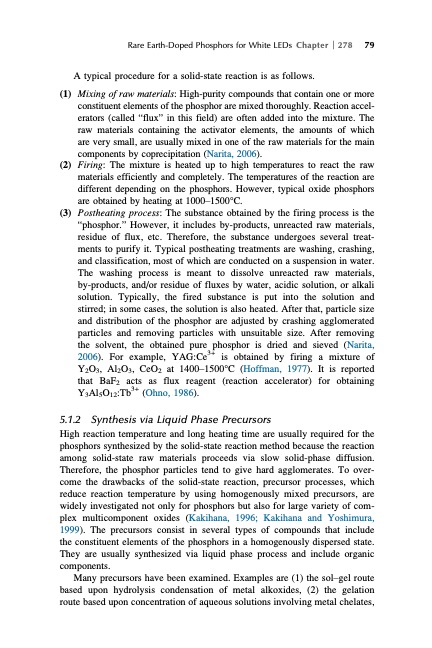
PDF Publication Title:
Text from PDF Page: 115
Rare Earth-Doped Phosphors for White LEDs Chapter 278 79 A typical procedure for a solid-state reaction is as follows. (1) Mixingofrawmaterials:High-puritycompoundsthatcontainoneormore constituent elements of the phosphor are mixed thoroughly. Reaction accel- erators (called “flux” in this field) are often added into the mixture. The raw materials containing the activator elements, the amounts of which are very small, are usually mixed in one of the raw materials for the main components by coprecipitation (Narita, 2006). (2) Firing: The mixture is heated up to high temperatures to react the raw materials efficiently and completely. The temperatures of the reaction are different depending on the phosphors. However, typical oxide phosphors are obtained by heating at 1000–1500°C. (3) Postheating process: The substance obtained by the firing process is the “phosphor.” However, it includes by-products, unreacted raw materials, residue of flux, etc. Therefore, the substance undergoes several treat- ments to purify it. Typical postheating treatments are washing, crashing, and classification, most of which are conducted on a suspension in water. The washing process is meant to dissolve unreacted raw materials, by-products, and/or residue of fluxes by water, acidic solution, or alkali solution. Typically, the fired substance is put into the solution and stirred; in some cases, the solution is also heated. After that, particle size and distribution of the phosphor are adjusted by crashing agglomerated particles and removing particles with unsuitable size. After removing the solvent, the obtained pure phosphor is dried and sieved (Narita, 2006). For example, YAG:Ce3+ is obtained by firing a mixture of Y2O3, Al2O3, CeO2 at 1400–1500°C (Hoffman, 1977). It is reported that BaF2 acts as flux reagent (reaction accelerator) for obtaining Y3Al5O12:Tb3+ (Ohno, 1986). 5.1.2 Synthesis via Liquid Phase Precursors High reaction temperature and long heating time are usually required for the phosphors synthesized by the solid-state reaction method because the reaction among solid-state raw materials proceeds via slow solid-phase diffusion. Therefore, the phosphor particles tend to give hard agglomerates. To over- come the drawbacks of the solid-state reaction, precursor processes, which reduce reaction temperature by using homogenously mixed precursors, are widely investigated not only for phosphors but also for large variety of com- plex multicomponent oxides (Kakihana, 1996; Kakihana and Yoshimura, 1999). The precursors consist in several types of compounds that include the constituent elements of the phosphors in a homogenously dispersed state. They are usually synthesized via liquid phase process and include organic components. Many precursors have been examined. Examples are (1) the sol–gel route based upon hydrolysis condensation of metal alkoxides, (2) the gelation route based upon concentration of aqueous solutions involving metal chelates,PDF Image | HANDBOOK ON THE PHYSICS AND CHEMISTRY OF RARE EARTHS

PDF Search Title:
HANDBOOK ON THE PHYSICS AND CHEMISTRY OF RARE EARTHSOriginal File Name Searched:
Chemistry-Rare-Earths-49.pdfDIY PDF Search: Google It | Yahoo | Bing
Sulfur Deposition on Carbon Nanofibers using Supercritical CO2 Sulfur Deposition on Carbon Nanofibers using Supercritical CO2. Gamma sulfur also known as mother of pearl sulfur and nacreous sulfur... More Info
CO2 Organic Rankine Cycle Experimenter Platform The supercritical CO2 phase change system is both a heat pump and organic rankine cycle which can be used for those purposes and as a supercritical extractor for advanced subcritical and supercritical extraction technology. Uses include producing nanoparticles, precious metal CO2 extraction, lithium battery recycling, and other applications... More Info
| CONTACT TEL: 608-238-6001 Email: greg@infinityturbine.com | RSS | AMP |